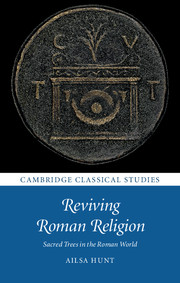Book contents
- Frontmatter
- Dedication
- Contents
- List of figures
- Acknowledgements
- 1 Rooting in: why give time to sacred trees?
- 2 A brief history of tree thinking: the enduring power of animism
- 3 How arboreal matter matters: rethinking sacrality through trees
- 4 Arboriculture and arboreal deaths: rethinking sacrality again
- 5 Confronting arboreal agency: reading the divine in arboreal behaviour
- 6 Imagining the gods: how trees flesh out the identity of the divine
- 7 Branching out: what sacred trees mean for Roman religion
- Appendix
- Bibliography
- Index
2 - A brief history of tree thinking: the enduring power of animism
Published online by Cambridge University Press: 05 September 2016
- Frontmatter
- Dedication
- Contents
- List of figures
- Acknowledgements
- 1 Rooting in: why give time to sacred trees?
- 2 A brief history of tree thinking: the enduring power of animism
- 3 How arboreal matter matters: rethinking sacrality through trees
- 4 Arboriculture and arboreal deaths: rethinking sacrality again
- 5 Confronting arboreal agency: reading the divine in arboreal behaviour
- 6 Imagining the gods: how trees flesh out the identity of the divine
- 7 Branching out: what sacred trees mean for Roman religion
- Appendix
- Bibliography
- Index
Summary
Tree thinking: getting back to roots
Today trees sit in a blindspot for scholars of Roman religion. Yet if we take a long view back over the history of scholarship on Roman religion, this sidelining of trees becomes an ironic coda to almost a century and a half of unmitigated scholarly enthusiasm for sacred trees. Why have sacred trees been pushed to the margins in this way? What effect has the sacred tree's fall from grace had on our own scholarship? Understanding the history of our thinking about sacred trees – the way it moulds our presumptions about their significance within Roman religion and dictates what questions we ask about them – is the major aim of this chapter.
From early in the nineteenth century until well into the twentieth century sacred trees were overwhelmed with scholarly attention, thanks to the way they were felt to speak to concerns at the heart of intellectual culture during this period. The nineteenth century saw thinkers much exercised by questions about the origins of mankind and human culture, and when it came to religious studies the central aim was to identify the most primitive form of religion and then to trace its adaptations and developments down to the present day. Confidently titled books such as Caird's The Evolution of Religion (1893) or Allen's The Evolution of the Idea of God (1897) say it all. Certainly the search for the originary germ of religion was by no means entirely new – Hume's Natural History of Religion had argued in 1757 that this lay in people's fear of natural forces and consequent deification of them – but the nineteenth century saw an intensification of this particular scholarly mode. No small part was played in this by the influence of Darwin's evolutionary theories, which sanctioned the rationale of pursuing an original idea and tracing its developments in linear, chronological fashion. At the same time, this mode of scholarly enquiry was also deeply Christianocentric, as scholars pondered how it was possible that the most primitive religious thinking could eventually evolve into the sophistication of the Christian faith, something Caird sums up in laying out the central methodological questions for those who take ‘the idea of development’ as ‘a key to the history of religion’.
- Type
- Chapter
- Information
- Reviving Roman ReligionSacred Trees in the Roman World, pp. 29 - 71Publisher: Cambridge University PressPrint publication year: 2016



